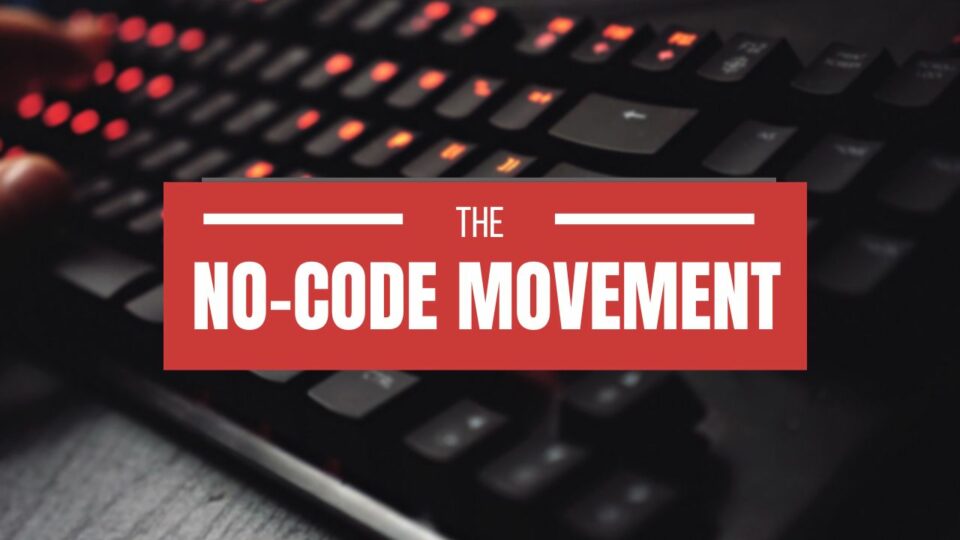While the global pandemic has resulted in millions of people losing their jobs, at the same time in the US, applications to register new businesses has risen by nearly 40% compared to the same period only a year ago.
Many factors contribute to this seismic shift in the business landscape. One of those factors–and not, by any stretch the least significant–is the accessibility of technology and the boom in SaaS (Software as a Service), which had empowered millions to turn their ideas into business ventures.
Nowadays the tools exist to allow anyone with an idea, determination, and persistence to build and run their own company. The technology at their disposal has been developed with the intent to make it flexible and easy to use. This trend in software development has been coined the ‘no-code movement’.  The no-code movement is especially noticeable in the SaaS sector. And though it is true that no code-writing skills are needed to get on board, this movement is nothing new to the IT world. In fact, it is merely an extension or evolution of software development that has been going on ever since the early days of software development.
The no-code movement is especially noticeable in the SaaS sector. And though it is true that no code-writing skills are needed to get on board, this movement is nothing new to the IT world. In fact, it is merely an extension or evolution of software development that has been going on ever since the early days of software development.
What has changed–and it is a noteworthy change–is just how widespread and accessible the software has become. Today, a wealth of SaaS tools allow entrepreneurs to build websites, design apps, or start an eCommerce trade with little to no technical know-how.
Let’s take a look at how we got here and what it means for entrepreneurs going forward.
From Low-Code to No-Code
In 2014, a leading market research company, Kissflow, coined the term ‘low-code’ to classify new software being developed that focused on simplicity and ease of use.
Though ‘low-code’ programs had been in existence since as far back as 1985 (when Microsoft launched Excel) it wasn’t until the advent of mobile apps and the influx of site-building platforms such as WordPress or Shopify that a term came about to highlight these tools’ accessibility.
When more and more business transactions, consumer behavior, entertainment, and even social interactions started to go online–and at an alarming speed–many people, young and old alike, feared they might get overwhelmed or outpaced by these technological advancements.
From the early days of software development, these fears or concerns were acknowledged and addressed. The buzzwords swarming around design teams became: UX (user experience), accessibility, and out-of-the-box design. Then came low-code, so no-code was the inevitable next step.
Semantics, or the Marketing of the No-Code Movement
 SaaS tools that enable users to complete a task without having to write code are no-code tools. But that definition fits almost any SaaS product.
SaaS tools that enable users to complete a task without having to write code are no-code tools. But that definition fits almost any SaaS product.
SaaS building tools such as Bubble or Webflow, allow the user to design and build websites or apps without the need to write code. They work by providing the user with templates and building blocks that can be arranged and manipulated according to the user’s needs and imagination.
These types of tools are also known as out-of-the-box SaaS tools. ‘Out-of-the-box’ meaning: ready to be used immediately upon opening.
In addition to app building or website building, no-code platforms or out-of-the-box SaaS tools include CRM (Customer Relationship Management) platforms such as Salesforce or Pipeline.
These kinds of tools represent the majority of no-code platforms.
Origins of no-code platforms

To start at the beginning of no-code, we could, technically, go as far back as 1985 when Microsoft launched Excel. However, since no-code didn’t really kick-off as a ‘movement’ until the launch of web-building and app-building platforms in the early to mid-aughts, that seems like a more appropriate place to start.
WordPress Launch in 2003
WordPress is a content management system (CMS), free and open-source, that allows users to design their own web pages and create and manage content for their sites.
WordPress started out as blogging software intended to fill a market need when the then-popular software b2/catalog was discontinued by its developers. But it has, since then, taken on phenomenal proportions. Today nearly 32% of websites on the internet were created using WordPress, there are over 55,000 plug-ins, and it has been downloaded over 7 million times.
The developers of WordPress started as an open-source community, meaning they shared their discoveries and tools freely with one another in the hope that this would spark creativity and further productivity.
When trying to understand and appreciate the no-code movement, it is important to highlight the influence of open source communities. The philosophy, practices, and ethos of open source communities are, in large part, the same as those that drive the no-code movement.
Shopify launches in 2004
Though its first iteration was launched in 2004, Shopify as we know it today–a platform where users can build and manage their own eCommerce shop–was launched in 2006.
Three years later, Shopify released the App Store and API, which allowed users or companies to create and sell their own apps for the store, to be used in conjunction with the Shopify platform.
The popularity of Shopify as an eCommerce website and online shop building and management platform has fueled a wealth of developers and entrepreneurs to create apps for the App Store. As of the date of this article, The Shopify App Store boasts a selection of well over 3,000 apps.
The Boom of the 2010s
Customizable tools took on whole new proportions in the 2010s. With platforms such as Bubble, Zappier, or Webflow the level of sophistication and the design possibilities reached new heights.
The success of these platforms has sparked others to follow suit, and we continue to reap the benefits of this snowball effect.
Building Blocks of the No-Code Movement
No-code should not be mistaken to mean ‘simple’ or ‘unsophisticated’ software. Instead, a helpful analogy could be to consider building an app or a website using preformatted yet malleable building blocks.
Using a development environment that is visual and intuitive, no-code platforms allow users to create or design with drag-and-drop tools, adding and modifying components according to their desires. All with no prior coding knowledge needed.
What does the No-Code Movement Mean for Developers?
It’s important to bear in mind that no-code was initially developed by developers and for developers. In an open-source environment, no-code allowed developers to use someone else’s idea and run with it in a whole new direction.
The no-code movement is a huge advantage for developers. Contrary to pessimistic thinking, taking code out of the development process does not, in turn, lessen the need and thus the opportunities for developers. No-code does not threaten their jobs; it helps make them more efficient and more productive.
No-code automates what would otherwise have to be entered manually. Developers are now free to explore further horizons, to go where no-code can’t go at the moment. Not to mention the huge boost in the number of users and eCommerce entrepreneurs the no-code movement has fostered. This boom in the market creates new needs and new clients for developers.
What does this mean for Entrepreneurs?
 We have seen a different kind of online entrepreneur emerge from the no-code movement. We are seeing younger people opting to join or create their own start-up rather than enter the workforce by a more traditional route.
We have seen a different kind of online entrepreneur emerge from the no-code movement. We are seeing younger people opting to join or create their own start-up rather than enter the workforce by a more traditional route.
We are seeing the requirements for starting your own business diminish greatly. High education levels or access to considerable start-up capital, which were in the past staples of entrepreneurs, are today ‘perks’ and not viewed as indispensable.
- Limited initial financial investment
To go from idea to design then to prototype and testing requires little to no start-up capital. This would have been nearly unheard of a generation ago.
It is true that large investments are perhaps needed to scale and market the product. And a large number of investment firms and venture capitalists are there to seize the opportunity created by an ambitious entrepreneur.
- From idea to testing in record time
The ease and accessibility of development tools mean that you could be up and running and testing out a scaled-down version of your product quickly. The benefits of this kind of turnaround are multiple:
- You won’t be bogged down with overhead while you wait for the product to be marketable
- You can quickly pivot off a bad idea or quickly tweak a concept to make it work.
- You can capitalize on trends instead of designing while the trend comes and goes.
In short, the number 1 barrier for people starting their own business, initial capital, has been, for all intents and purposes, removed.
The number 1 reason for a new business to fail, a bad (not marketable) or untenable idea, has been reduced to a mere hic-cup and is no longer a reason to pack it all in.
Transitioning from Freelance to Entrepreneur
 Given the relative ease and speed at which a business or service can be created, starting your own company doesn’t have to be a full-time job–at least not in the beginning.
Given the relative ease and speed at which a business or service can be created, starting your own company doesn’t have to be a full-time job–at least not in the beginning.
We are seeing more and more employees working on their ideas on the weekend or in their spare time then choosing to make the jump when they feel they and their product are ready.
We are seeing more and more people who start off as freelancers or contracted workers turn their skills into viable businesses. With these types of contracts, freelancers have the flexibility and often the low aversion to risk needed to launch their own company.
Final Remarks
Thanks to out-of-the-box SaaS tools (or, no-code platforms) it has never been easier to start your own business or service.
Basically, with an idea and some gumption, you’re good to go. Though, obviously, success is not guaranteed.
Being an entrepreneur means working for yourself. Sounds enticing, provided you’re good at being your own boss.
If you’ve been contemplating creating and managing your own business, what’s stopping you? It certainly can’t be the tools you’d need to get your business up and running. It must be something else. Probably not the money; most of the tools (at least a version of them) require little to no money to start with, like affiliate marketing for example.
So, for fewer and fewer people, the list of things stopping them from taking the plunge into entrepreneurship has shrunk if not disappeared altogether. As technology continues to be so prevalent and so accessible, thanks to movements such as no-code, we will see this trend only increase exponentially.



